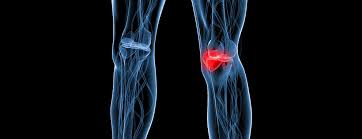Anterior knee pain, also known as patellofemoral pain syndrome (PFPS), is one of the most common conditions affecting active individuals. It is estimated that 2.5 million runners are diagnosed with PFPS each year, with females being at greater risk. Studies have also shown that PFPS can be very stubborn, with the majority of cases affecting function for at least 5 years, and a very large percentage of individuals suffering more than one episode of pain.

Anterior knee pain can often be easily diagnosed by health care providers, with common symptoms including pain at the front of the knee, or behind the kneecap (retropatellar). Occasionally, “crepitus”, or a cracking/grinding sensation can also be felt at the knee, especially with squatting or going up or down stairs. Other symptoms may include aching at the anterior knee with prolonged sitting or driving (positive “moviegoer’s” sign).
Although anterior knee pain may be a relatively simple diagnosis, it does not necessarily imply a simple cause. Physical therapists use their evaluation skills to assess how factors locally (around the knee), proximally (above the knee) and distally (below the knee) contribute to anterior knee pain, and develop an effective treatment plan.
Local factors include patellar maltracking, where the kneecap does not track efficiently through the groove at the end of the thigh bone, or femur. Other local factors can include decreased strength of the quadriceps muscles at the front of the thigh. Common interventions can include various taping or bracing techniques, and exercises to increase quadriceps strength and facilitation.
Distal factors can include suboptimal foot and ankle mechanics, as well as abnormal or excessive shoe wear. Common issues at the foot/ankle include excessive pronation or limited mobility/flexibility of the ankle joint or calf musculature. Physical therapists can make recommendations regarding shoe types as well as inserts/orthotics that can optimize foot and ankle mechanics, decreasing harmful stresses from being transmitted up the leg. They can also provide manual therapy and exercise prescription to address soft tissue or joint restrictions.
Proximal factors may include weakness of muscles in the hip region, such as the hip abductors and external rotators. Physical therapists can assess for muscle weakness, and develop an exercise regimen to strengthen these muscles and reduce excessive medial, or valgus, collapse of the thigh – resulting in decreased harmful patellofemoral stresses.
Although anterior knee pain can be an impediment to a normal, active lifestyle – a holistic and thoughtful treatment approach by your physical therapist can likely result in a positive outcome, allowing return to daily activities and sports without pain.
If anterior knee pain is affecting your ability to participate in the activities you enjoy, contact ProActive Physical Therapy and Sports Medicine today to get your knees moving in the right direction!

